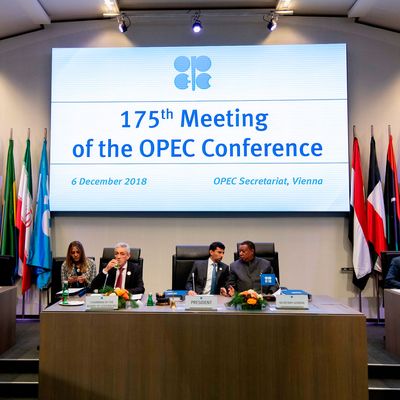
Oil prices in free fall — a barrel of West Texas Intermediate crude now sells for $52, down a third since October — has been good news for American consumers, but it’s bad news for countries with oil-dependent economies. That is why leaders from Organization of Petroleum Exporting Countries (OPEC) have been meeting in Vienna and trying to agree on a production cutback to push up prices.
But they haven’t been able to reach an agreement.
These days, OPEC tries to coordinate with Russia, which isn’t an OPEC member, because the group doesn’t believe it can affect global oil prices enough through the actions of its own members. And the Persian Gulf countries that dominate OPEC want a larger cutback than Russia is willing to agree to.
As Bloomberg describes, this split is partly driven by conflicting interests: The Gulf producers are mostly concerned about how low oil prices affect their government budgets, but Russia doesn’t want prices to rise too much. Bloomberg cites a Kremlin official who worried higher gasoline prices could upset consumers and reduce political support for Vladimir Putin’s economic policy.
But a broader reason OPEC control of oil prices isn’t working anymore is that the world oil market has changed in ways that make a cartel strategy less effective.
The usual idea behind a cartel is: You agree to limit production, and that means you sell less oil, but you make more profit per barrel because prices have to rise to bring demand in line with the reduced supply. Historically, constraining supply has been an effective way to change the oil price, because non-OPEC countries had limited flexibility to increase their production when OPEC production declined, and because consumer behavior is inelastic, especially in the short term. High oil prices might eventually cause you to buy a smaller car or live closer to work, but probably not right away.
The rise of fracked shale oil has changed the non-OPEC production side of that analysis. There have been a lot of headlines recently about how, because of the shale boom, the U.S. is now producing so much oil we are a net oil exporter. But as importantly for OPEC’s loss of control, the shale boom makes the U.S. a more elastic oil producer.
What I mean by that is, some of the oil in the ground under the U.S. is easy (cheap) to extract, and some of it is hard (expensive) to extract. We produce the easy oil in any market condition. But if OPEC moves to cut back supply and drive up prices, U.S. producers will become more inclined to find and extract the expensive oil. In the medium term, that will tend to push U.S. production volumes up and oil prices partially back down.
Among other things, that means a production cut just doesn’t produce as much benefit to OPEC producers as it used to. After a while, they’ll be faced with prices not that much higher than today, and a smaller share of the global market.
With less total benefit to go around from a production cut, cartel members are more likely to get bogged down in fights over who exactly should do the cutting — it’s harder to put together a positive-sum deal for every member of the cartel. And of course, political divisions among OPEC members also don’t help, and neither does Saudi Arabia’s need to stay in the Trump administration’s good graces.
But consumers shouldn’t get too excited about a weak OPEC. It’s likely the fall in oil prices over recent months — the one that raised OPEC’s urgency to find a supply-reduction deal — is driven by some of the same factors that are driving stock prices and bond yields down: a worsened outlook for global economic growth, and therefore lower expected demand for fuel.